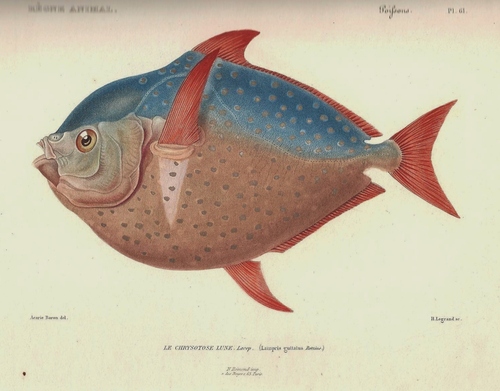
Opah
The Atlantic bluefin tuna (Thunnus thynnus) is a highly migratory, large pelagic fish known for its incredible speed, size, and commercial value. As one of the top predators in the marine ecosystem, it plays a crucial role in maintaining the balance of ocean life. This magnificent species is also a symbol of the challenges of sustainable fisheries management.
5 10 years
Lifespan
200 cm
Length
Least Concern
Conservation Status
1 km/h
Swimming speed
Carnivorous
Diet
Nomadic
Migration
Appearance Overview
The Atlantic bluefin tuna is renowned for its large, torpedo-shaped body, dark blue-black back, and silvery-white belly.
Color
Dark blue-black on top, silvery-white underside
Body Shape
Torpedo-shaped
Fins
Two dorsal fins, with the second being taller than the first
Finlets
Small, yellow finlets running from the dorsal and anal fins to the tail
Length
Up to 13 feet (4 meters)
Weight
Up to 2,000 lbs (907 kg)
Diet
Carnivorous, feeding on a variety of fish, squid, eels, and crustaceans.
Feeding Behavior
Highly active predator that uses its speed and agility to hunt. It often hunts cooperatively, herding and trapping prey.
Social Behavior
Forms large schools, particularly during migration and spawning. Schools can be mixed with other tuna species.
Commercial Relevance
Highly prized in the sushi and sashimi market, leading to significant economic value. One of the most expensive fish in the world.
Conservation measures
Subject to international fishing quotas and management plans through organizations like ICCAT. Efforts include monitoring, research, and combating illegal fishing.
Status
Endangered
Threats
Severe overfishing, particularly for the sushi market, has drastically reduced populations. Climate change and habitat degradation also pose threats.
Habitat Distribution
Depth Range
0-1,000 meters, but typically found in the upper layers of the ocean.
Geographic Range
Atlantic Ocean, including the Mediterranean Sea, Gulf of Mexico, and the coasts of North America and Europe.
Preferred Environment
Temperate and subtropical waters; prefers open ocean but can also be found in coastal areas.
Reproduction and Life Cycle
Breeding Habits
Spawns in warm waters, primarily in the Mediterranean Sea and the Gulf of Mexico. Spawning occurs from May to July.
Development Stages
Eggs hatch into larvae, which are planktonic. Juveniles grow rapidly, developing into highly migratory adults.
Fecundity
Females can produce up to 30 million eggs per spawning season.
Maturity Age
Reaches sexual maturity at approximately 4-8 years of age.
Faqs about Opah
How long do Atlantic bluefin tuna live?
Atlantic bluefin tuna can live up to 40 years.
Where can Atlantic bluefin tuna be found?
They are found in the Atlantic Ocean, from the Mediterranean Sea to the Gulf of Mexico and the coasts of North America and Europe.
What do Atlantic bluefin tuna eat?
They are carnivores, primarily feeding on smaller fish, squid, and crustaceans.
Are Atlantic bluefin tuna migratory?
Yes, they are highly migratory, traveling long distances across the Atlantic Ocean for feeding and spawning.
Why are Atlantic bluefin tuna endangered?
They are endangered due to overfishing, particularly driven by high demand in the sushi market.
How big can Atlantic bluefin tuna get?
The largest recorded Atlantic bluefin tuna weighed around 2,000 lbs (907 kg).
Are Atlantic bluefin tuna warm-blooded?
Atlantic bluefin tuna are warm-blooded, unlike most fish, allowing them to maintain a higher body temperature than the surrounding water.
Where do Atlantic bluefin tuna spawn?
They primarily spawn in the Mediterranean Sea and the Gulf of Mexico.
When do Atlantic Bluefin Tuna reach maturity?
Atlantic bluefin tuna reach sexual maturity at around 4-8 years of age.
Copyright @ Nature Style Limited. All Rights Reserved.
 English
English